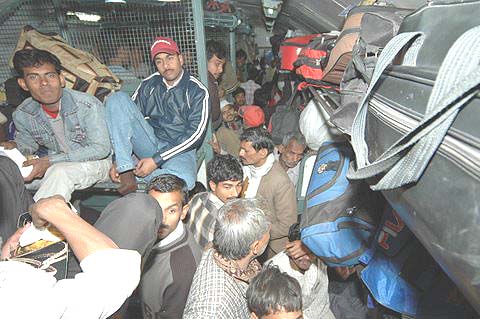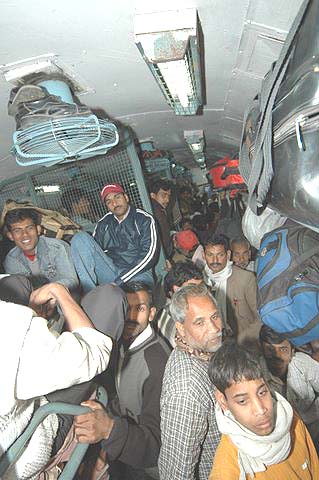 Patna, Nov 7 (IANS) Airports, railway stations and bus terminuses have been packed with milling crowds as hundreds of thousands of migrants from Bihar, who work all over the country and abroad, have returned to their homes in Bihar to celebrate and infuse "new life" to the four-day Chhath festival, the state's biggest community celebration. Patna, Nov 7 (IANS) Airports, railway stations and bus terminuses have been packed with milling crowds as hundreds of thousands of migrants from Bihar, who work all over the country and abroad, have returned to their homes in Bihar to celebrate and infuse "new life" to the four-day Chhath festival, the state's biggest community celebration.
The returnees also give a huge boost to the rural economy.
 A group of factory workers - Lakhender Rai, Suresh Choudhary, Raju Paswan, Maheshwar Singh and Saryu Yadav - who reached Patna railway station Wednesday from Tamil Nadu and Andhra Pradesh were happy to be back. "Now, I will leave for my village in Vaishali district. For this day I have worked hard for months...Finally, I will be with my family and friends to celebrate Chhath," said Lakhender Rai, in his mid 40s, who works in Coimbatore in Tamil Nadu. A group of factory workers - Lakhender Rai, Suresh Choudhary, Raju Paswan, Maheshwar Singh and Saryu Yadav - who reached Patna railway station Wednesday from Tamil Nadu and Andhra Pradesh were happy to be back. "Now, I will leave for my village in Vaishali district. For this day I have worked hard for months...Finally, I will be with my family and friends to celebrate Chhath," said Lakhender Rai, in his mid 40s, who works in Coimbatore in Tamil Nadu.
Maheshwar Singh, in his early 30s, too was upbeat.
"I am really lucky to be with my family in Arwal district nearly after a year to celebrate Chhath. There is nothing like this," Singh who works in a factory near Hyderabad, told IANS.
They are just two of hundreds of thousands of migrant workers who plan to enjoy a few days in their villages before returning to earn their livelihood.
According to police officials, more than two million migrant workers have already reached their homes in last few days. The four-day Chhath festival began Wednesday and ends Saturday morning.
Millions of people, most of them married women, throng the river banks in the morning to bathe before preparing traditional food.
Celebrated six days after Diwali, Chhath is dedicated to Surya, the Sun god. During the festival, married women observe a fast for 36 hours. Devotees offer wheat, milk, sugarcane, bananas and coconuts to the gods.
The main ritual is known as arghya -- when devotees stand waist-deep in water and offer prayers to the Sun god on the banks of rivers.
Hundreds of migrant workers are still coming home, packing buses and trains from virtually every part of the country.
"Hundreds of thousands have already reached their homes and more will arrive...," a police official told IANS.
This is the season when Biharis insist on being in Bihar.
"Thanks to the coming of migrant workers in Bihar, mostly in rural areas, for Chhath, it has added a new life to the festival and given fresh oxygen to socio-economic activities. Each migrant worker brings some (money) that increases the purchasing power and boosts economy during and after Chhath...," said Ranjeev, an activist who is associated with the flood-prone Kosi belt of north Bihar that has witnessed large-scale migration for livelihood.
Ranjeev said that not just families but traders and shopkeepers too in rural areas wait for the arrival of migrant workers during Chhath.
"Soon after their arrival, the rural economy picks up momentum as they invest to complete pending work including construction (and) to purchase items for marriage," he said.
Suresh Choudhary, Raju Paswan and Saryu Yadav, who migrated in search of livelihood, recalled that earlier they had to wait for hours to reach their native villages due to bad roads. "With good roads constructed in Bihar in the last five to six years, we are no longer worried about how to reach home. Even electricity has come to my village early this year," Yadav told IANS.
According to experts, it is difficult to estimate the number of labourers from Bihar working in various parts of India.
Most of the Bihari labour concentration is said to be in Punjab, Delhi, Haryana, Assam, Rajasthan and Gujarat, Tamil Nadu and Andhra Pradesh. Cities such as Mumbai, Chennai, Bangalore, Kolkata and Pune also have a sizeable number of people from Bihar.
The state government, however, has no record.
Most migrants from Bihar work in farms, factories, construction and infrastructure sites and do many other jobs. Many are also professionals - and are counted among the best in the field.
|
